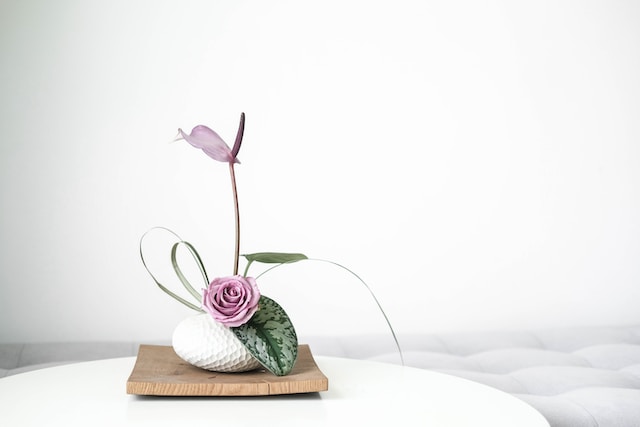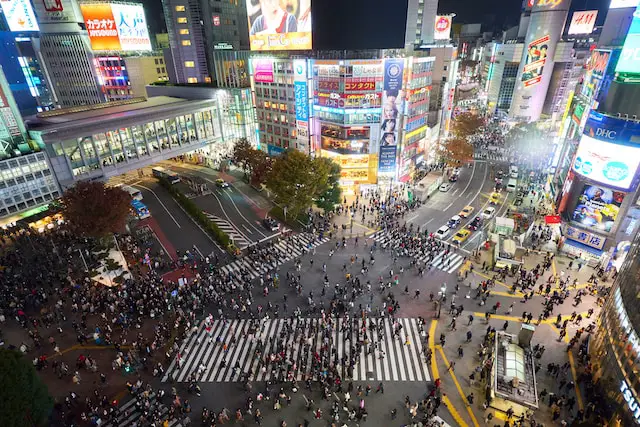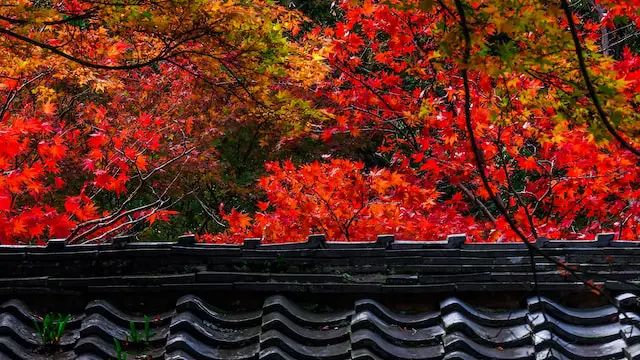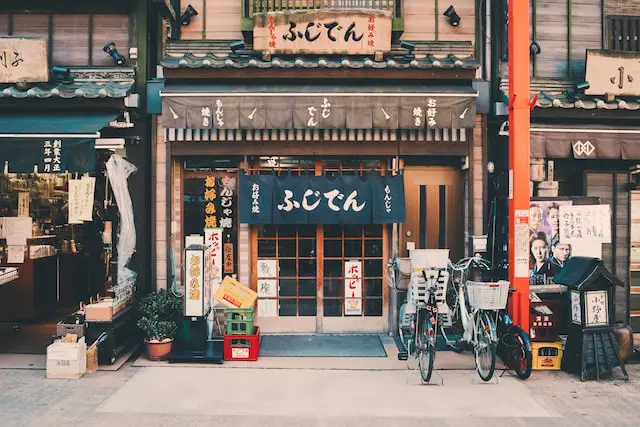Welcome to our exploration of the elegant and profound world of traditional Japanese arts. Rooted in centuries of meticulous craftsmanship and spiritual depth, the arts of Japan embody the very essence of Japanese culture. They offer perspectives into Japan’s rich heritage, steeped in tradition, yet undoubtedly dynamic.
The journey ahead will guide us through the peaceful and mindful practice of Ikebana, the intricacy and meditative nature of Japanese calligraphy, and the vibrant and dramatic spectacle that is kabuki theatre. These artistic expressions provide a glance into authentic Japan, its patience, precision, and pursuit of perfection.
Whether you’re a seasoned admirer of traditional Japanese arts or embarking on your exploration, we hope to shine a light into the ancient paths that continue to inspire and shape the cultural heart of Japan.
What is Ikebana? (Ikebana: The Art of Japanese Flower Arrangement)
Deeply rooted in Japan’s rich heritage, Ikebana, often referred to as the Art of Ikebana, encapsulates the beauty and depth of traditional Japanese arts. Saturated with age-old rituals and philosophies, Ikebana is much more than just a simple Japanese flower arrangement; it is a symbol of harmony with nature and a refined manifestation of Japan’s aesthetic values.
The practice of Ikebana dates back to the 7th century when floral offerings were made at altars. Over time, these arrangements have evolved into a spiritual process, where one quietly meditates while appreciating the delicate and transitory beauty of flowers. It is said that in the careful placement of the plant material, practitioners seek to find a balance between mankind, the spirit, and nature. This distinct form of art principle underscores how closely Japanese culture reveres nature as well as balances structure and spontaneity.
It was Buddha’s disciple, Prince Shotoku, who is credited with introducing Ikebana to Japan. He had a deep respect for life in all forms, and this belief system provides the philosophical foundation for Ikebana. The Prince believed that mankind could develop a profound sense of gratitude and a deeper understanding of true reality by observing and contemplating the distinctive beauty of flowers.
The historic Sonsei school then diversified Ikebana’s styles and techniques over the centuries, giving birth to various Ikebana schools. Each school explores different concepts, forms, and expressions, making Ikebana a deeply personal and introspective art—one that artistically mirrors authentic Japan.
Whether you’re an art enthusiast, a flower lover, or someone deeply interested in Japanese culture, Ikebana offers a tranquil and poignant experience that opens a window into the heart of traditional Japanese arts and Japan’s unique connection with nature. Stay tuned to learn about the different schools of Ikebana and how you can even get hands-on experience with this treasured art form while visiting Japan.
Types of Ikebana Styles
The art of Ikebana, with its innumerable styles, has evolved over centuries and is deeply etched in Japan’s rich heritage. The Ikebana styles widely seen today can be classified into various traditional, as well as modern schools of thought, each showcasing different principles and aesthetics.
Ikenobo Ikebana, traced back to the 15th century, is the oldest school. Emphasizing formality, mindfulness, and a spiritual connection with nature, this type of arrangement often highlights the natural shapes and lines of the flowers and other materials used.
The Ohara School, another traditional style, focuses on depicting natural landscapes. The “Moribana” style under Ohara School, which means “piled-up flowers”, often uses a shallow, wide dish and forms a triangular structure. It brilliantly captures the beauty of the seasons and invokes the sense of a broader landscape rather than a single flower arrangement.
A more modern and free-spirited approach is found within the Sogetsu School. With fewer rules and more emphasis on personal expression, these arrangements can often incorporate abstract elements, non-living materials, and fit within both classical and contemporary contexts.
Despite their differences, every Ikebana style holds the same core values, representing the Japanese appreciation for nature’s beauty, the adherence to balance and minimalism, and the pursuit of tranquility through the art of Japanese flower arrangement. Each arrangement, regardless of style, offers a unique journey of expression and understanding harmony with nature.
Indeed, the profound world of Ikebana styles highlights the heart of authentic Japan and its delicate interplay between tradition and innovation.
How to Experience Ikebana in Japan
If appreciating this harmonious and elegant art form from a distance isn’t enough, Japan offers countless opportunities to immerse in the art of Ikebana – Japanese flower arrangement – firsthand. Whether novice or expert, you can seek enchantment in the simple act of arranging flowers, from the bustling heart of Tokyo to the serene landscapes of Kyoto.
For those in Tokyo, Ikenobo Ikebana Society frequently holds Ikebana exhibitions, where one can view exquisite works of various Ikebana styles. Including those created by the most talented local artists. Marvel at these beautiful arrangements and feel a newfound appreciation for the delightful detail and thought put into each composition.
If hands-on learning entices you more, taking part in an Ikebana workshop is an excellent choice. In Kyoto, the birthplace of Ikebana, schools such as Sogetsu and Ohara offers classes for all levels, even for tourists and non-Japanese speakers. You will no doubt find tremendous satisfaction in bonding with nature and expressing your creativity under the insightful guidance of revered Ikebana masters.
Furthermore, be sure to visit cultural centers throughout Japan to connect deeper with the art of Ikebana. Not merely about arranging flowers, it is the practice of patience, respect, and introspection. As you become increasingly captivated by this exquisite art, your Japanese journey transcends into an unforgettable one, a true experience of your own personal harmony with nature.
Indeed, experiencing Ikebana in Japan will provide you with a splendid opportunity to participate in one of Japan’s most exquisite forms of traditional Japanese arts, enriching your experience, opening a window to authentic Japan, and offering a beautiful glimpse into Japan’s rich heritage.
Introduction to Japanese Calligraphy (Shodo)
In the realm of Japanese culture, the art of calligraphy, or shodo, stands as a phenomenal blend of discipline and creativity. This traditional Japanese art, a choreographed dance between ink and paper, exemplifies the written beauty of Japan.
Historically, shodo originated from China around 2000 years ago, making its way to Japan in the 6th century. Initially practiced by nobility and Buddhist monks, it was seen as a reflection of one’s character and a way to cultivate spiritual depth. The name itself, shodo, translates to “the way of writing”.
It involves carefully crafting each character with a brush and ink on rice paper, following a unique structure and order for each stroke. It’s not just about writing, but expressing oneself, their emotions, and their energy.
The aesthetics and principles of shodo are intricate. Each piece is a balance of subtlety and boldness, emptiness and fullness. Shodo highlights thoughtful movement, mindfulness, and harmony, promoting a state of Zen. Each stroke conveys the passing of time, the pressure applied, the speed, rhythm, and the spirit in that very moment. A well-balanced composition, the calligraphy reflects the unique beauty of well-crafted characters through each artist’s technique.
Explanation and historical background of Japanese calligraphy.
The world of Japanese calligraphy is vast, with nuanced styles. From kaisho style that is clear and precise, to the flowing and expressive sousho style, each script tells its own tale and takes the viewer on a journey through Japan’s rich history.
Today, let’s dive deeper into the captivating world of traditional art in modern Japan with a particular focus on the beautiful realm of Japanese calligraphy, or shodo. The blend of tradition and avant-garde thinking has crafted a unique platform where modern Japanese calligraphy is continuously finding fresh interpretations.
The tradition of shodo is so intricately woven into Japan’s cultural fabric that it subtly influences many aspects of the contemporary lifestyle. However, the intricate brush strokes and profound philosophy behind this art form remain constant. The steady hand of the past and the restless spirit of the present mingle within the script, bringing forth a design that is a quintessential representation of the written culture of Japan.
From stationeries to fashion design, from wall decor to digital art; the ubiquitous presence of contemporary shodo is quite admirable. Exhibitions showcasing a wide array of calligraphic expressions from emerging artists can be found everywhere in Japan. A multitude of schools, such as the Saiso Calligraphy School in Tokyo, fuse the historical heritage of calligraphy with innovative techniques, conducting specialized courses for individuals to explore the depths of this artform.
Renowned contemporary shodo artists like Shinrei YAMANE and Koji KAKINUMA effectively straddle this blend of generations and cultures, drawing inspiration from beyond the traditional aspects. By doing so, they illustrate the limitless potential of this art form and their work exudes the vibrancy of Japanese modern calligraphy.
Modern Usage of Japanese Calligraphy
Exploring modern Japanese calligraphy is truly an intriguing journey into the heart of traditional art in modern Japan, where the threads of the past elegantly entwine with the pulses of the present.
No visit to Japan would be complete without trying your hand at Shodo, a beautiful and intricate form of Japanese calligraphy. Shodo is more than mere writing; it’s a path to self-discovery and meditation.
Fortunately, many cultural centers and schools cater to foreign tourists who have a keen interest in traditional shodo classes. One of these venues is the Meiji Jingu Shiseikan in Tokyo. As part of their Cultural Program, they offer an immersive Shodo workshop Tokyo where you can learn the basic techniques under the guiding hands of an expert shodo artist.
For those who want a more comprehensive experience, the Japanese Calligraphy ‘Shodo’ Experience Kyoto run by “Kyoto Calligraphy Classes AABB” is another excellent choice. With a more relaxed atmosphere, you’ll be given the unique opportunity to explore your artistic side whilst learning more about the meticulous art form.
If you’re looking for something more distinct, you might consider “Wakalture Experience – Japanese Calligraphy and Cooking”. Here, not only will you learn the art of calligraphy, but you’ll also delight in a traditional home-cooking class, making it a truly immersive cultural and gastronomic experience.
Whether you’re an art lover, a culture enthusiast, or simply curious, these calligraphy experiences in Japan are sure to open new artistic and cultural horizons. So, don’t hesitate! Dive into Japan’s rich calligraphic tradition and uncover the written beauty of Japan for yourself.
Insight into Kabuki Theatre
The traditional Japanese arts have always been fascinating, but perhaps none more so than the dramatic and vivid world of Kabuki theatre. It is a significant cultural expression and an exceptional embodiment of Japan’s rich heritage.
Originating in the Edo period (1603 – 1868), Kabuki theatre is a classical performing arts form that brings together drama, dance, and music. This traditional Japanese theatre form presents elaborate tales that revolve around historical events, moral conflicts, love relationships, and more, all wrapped in spectacular aesthetics.
Beyond the captivating storylines, the allure of Kabuki lies in its unique elements. The flamboyant costumes worn by the actors, rigorous choreography, exaggerated acting, and unique kumadori makeup, with bold lines and striking colors representing the characters’ traits, all contribute to the mesmerizing spectacle. This form of performing arts also employs a revolving stage and trapdoors to create dramatic entrances and exits, enriching the theatrical experience.
The enchanting music sets the ambiance, with a full kabuki orchestra consisting of traditional Japanese instruments like the shamisen, flutes, and drums. The rich resonance of the shamisen resonates throughout the theatre, adding an emotive layer to the performance.
Whether you’re a fan of drama, history, or just plain beautiful, authentic Japan, Kabuki theatre offers a window into the enticing world of traditional Japanese performing arts. Its dramatic storytelling and grand presentation will undoubtedly leave you amazed and eager to explore more.
How to Experience Kabiki Theatre in Japan
If you find yourself entranced by the allure of the traditional Japanese performing arts, there’s simply no better place to experience the beauty and drama of Kabuki theatre than in its home country, Japan.
One of the most renowned places to watch Kabuki is in the traditional city of Kyoto. Minamiza Theatre, one of the oldest Kabuki theatres, offers authentic performances with English audio descriptions. This place allows you to have a full understanding of the plot regardless of language barriers.
One of Tokyo’s most prominent venues is the Kabukiza Theatre in Ginza. This theatre offers single act tickets – a perfect option for travellers who are short on time but expect a memorable taste of Kabuki experience in Kyoto. If you’re a real enthusiast and want to dive deep into theatre arts, consider the National Theatre in Tokyo, which showcases high-quality Kabuki performance and other traditional theatres.
Explanation and historical context of Kabuki theatre.
Remember, watching Kabuki also means appreciating the intricate makeup, extravagant costumes, and the alluring stage effects. Taking the time to learn about the symbols and motifs in Kabuki will help you appreciate the traditional Japanese theatre more deeply.
Whichever way you choose to immerse yourself in this art form, the shared experience of watching a Kabuki performance in Japan is a stirring journey into the heart of Japan’s rich heritage.
Whether in Tokyo or Kyoto, be sure to add a visit to a Kabuki theatre to your itinerary, and step into another world where history, drama, and art come together in a spectacle that is uniquely Japanese. The profound visual impact and the dramatic stories will linger with you long after you leave Japan.
In conclusion, Japan’s rich heritage offers an enigmatic fusion of vibrant colors, refined aesthetics, and profound philosophies, all beautifully expressed in its traditional arts. As a realm where the past and present coalesce, these arts capture the essence of Japan’s cultural genius.
Whether it’s the harmonious serenity of Ikebana, the palpable rhythm of the written beauty of Japan through Shodo, or the captivating performance in Kabuki theatre, each discipline resonates with the authenticity of Japan and beckons onlookers to delve deeper.
As a cultural tourist in Japan, immersing oneself in these art forms opens a door to appreciate the depth of traditional artistic Japan, where every stroke, arrangement, and performance tells a story. So, whether you’re an enthusiast or a first-time explorer, a journey through the mesmerizing landscapes of Japanese culture awaits you. Embark on it and experience traditional Japanese arts like never before.




